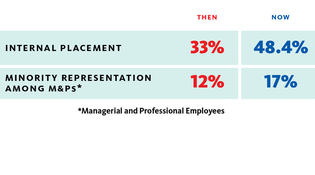 loading
loading
Light & VerityYale works to increase internal hiring Chart: Mark Zurolo ’01MFAView full image
In 1996, a top Yale manager strode into a union negotiating session and declared: “The ideal life cycle of an employee is six years.” True story, or apocryphal? Laurie Kennington ’01, now president of the clerical and technical employees’ union, admits she doesn’t know. The point is that, more than 15 years later, the story persists—a bitter reminder, from the employees’ viewpoint, that Yale considered their jobs not just dead-end but terminal. When Kennington tells the anecdote now, it is a story with two morals: how far the university has come in nurturing homegrown talent, and how far it has yet to go. Promoting from within is good both for employees who want to grow in their jobs and for the university, says Michael Peel, vice president for human resources and administration. Yet historically, only about one in three above-entry-level openings at Yale went to inside candidates. Among clerical and technical (C&T) positions, the rate was more like one in four. Those numbers are moving up. In the past two years, Yale has filled nearly half—48.4 percent—of its positions from within. Among C&Ts, the rate has risen substantially, to 38.5 percent. For managerial and professional (M&P) openings, internal placement has topped 50 percent and is running at 62 percent—the highest level in decades—this fiscal year, Peel reports. But for all that progress, Yale remains short of the goal set under Peel’s predecessor, John Pepper ’60, in 2005: to double the university’s overall internal hiring, to two-thirds, by 2009. (Pepper also vowed to boost the number of racial minorities in management and professional jobs, then at 12 percent. Peel predicts that number will be 17 percent by the end of this fiscal year.) “We’re on the journey for most of what we need to do,” says Peel. “But we’re far from where we need to be.” Hiring from within brings multiple benefits for Yale. The first is labor peace: creating better on-the-job opportunities “was one of the original issues for organizing Local 34 back in the 1980s” and has been on the table ever since, says Ken Suzuki, secretary-treasurer of the C&T union. The current contract brought the issue to a head. Anticipating cuts amid the 2008 economic crisis, the union demanded that laid-off employees get priority in applying for new job openings. The university agreed, and the two sides created mechanisms that worked—and that have remained in place beyond the agreed-upon time period. “It’s awkward to be hiring external people when you’re laying people off,” Peel acknowledges. Besides, Peel explains, when choosing among candidates with comparable qualifications, internal hiring benefits the university. It saves time—and therefore averts hardship in departments that need to get work done now. It saves money on recruiting, travel, interviews. And it produces better results. “It’s easy to be seduced by outside candidates who are selling themselves,” Peel says. “There’s a saying in HR that someone is never more promotable than on the day you hire them. With inside candidates, we make less mistakes. “Ultimately,” Peel adds, “there’s going to be a war for talent in the country, as the 80 million baby boomers vacate and are replaced by the 40 million GenY-ers.” The advantage will go to “those organizations that can develop and retain their own talent.”
The comment period has expired.
|
|